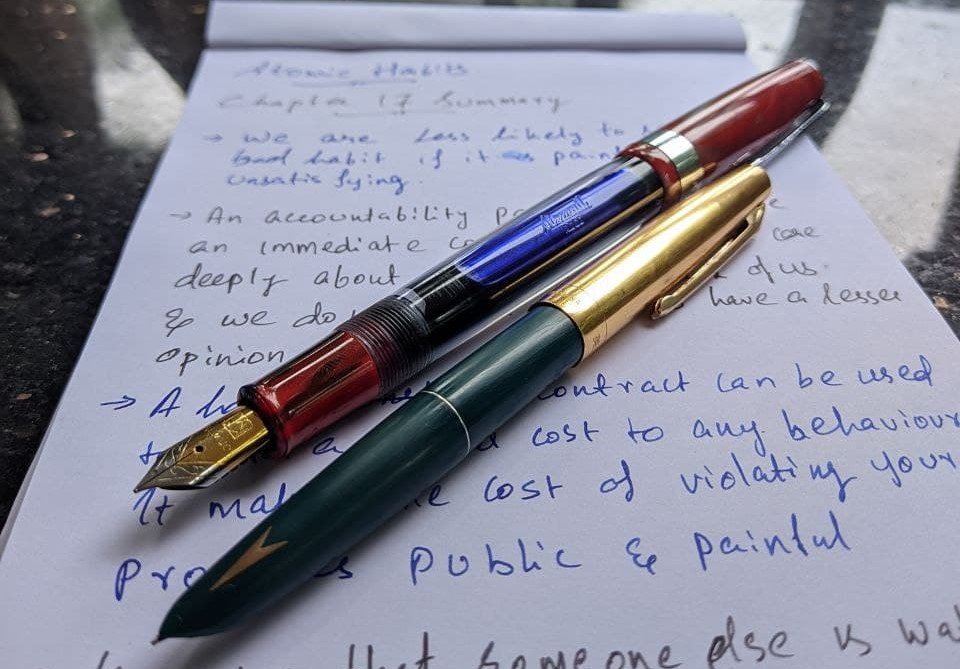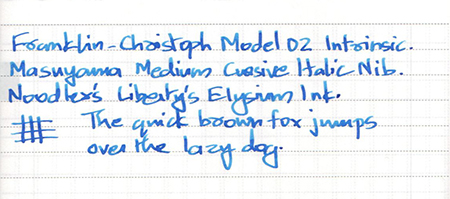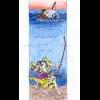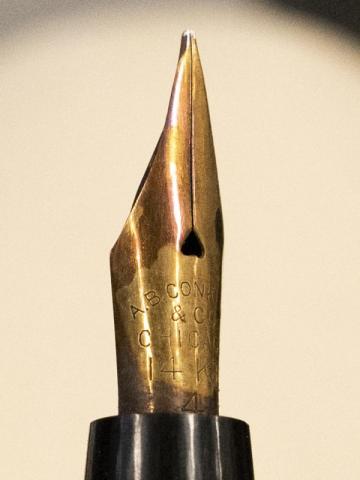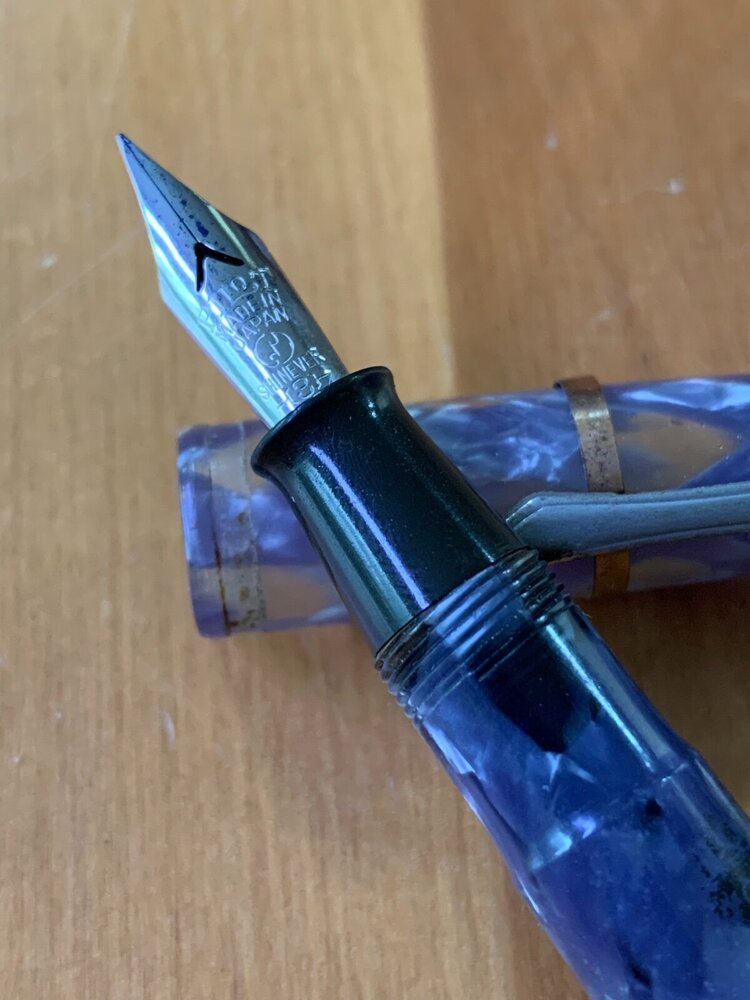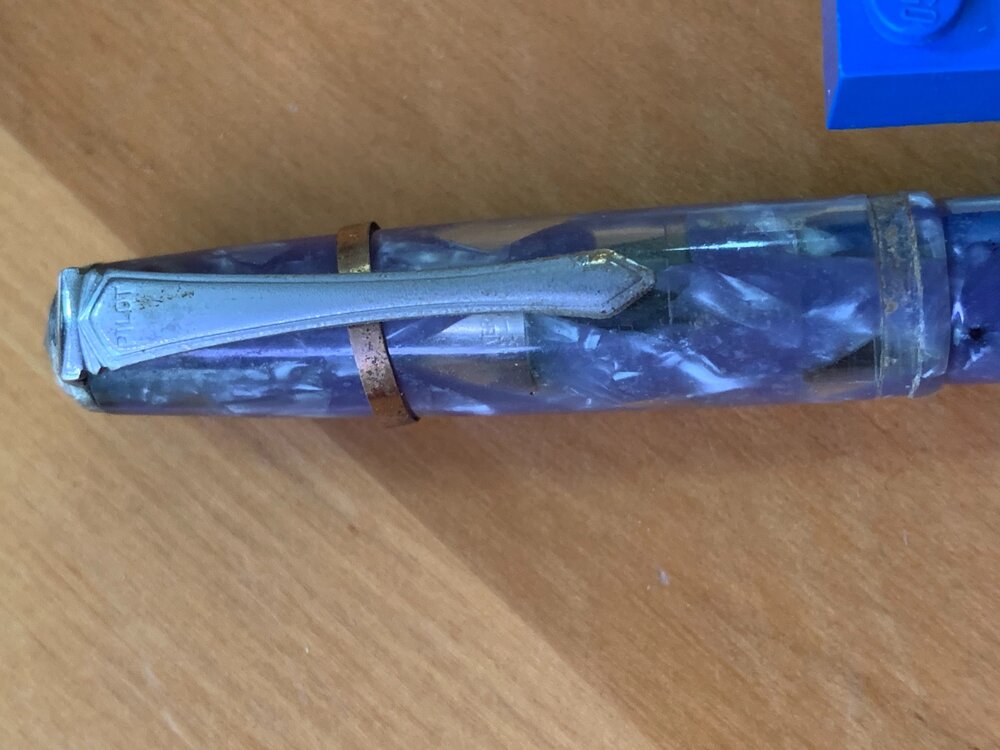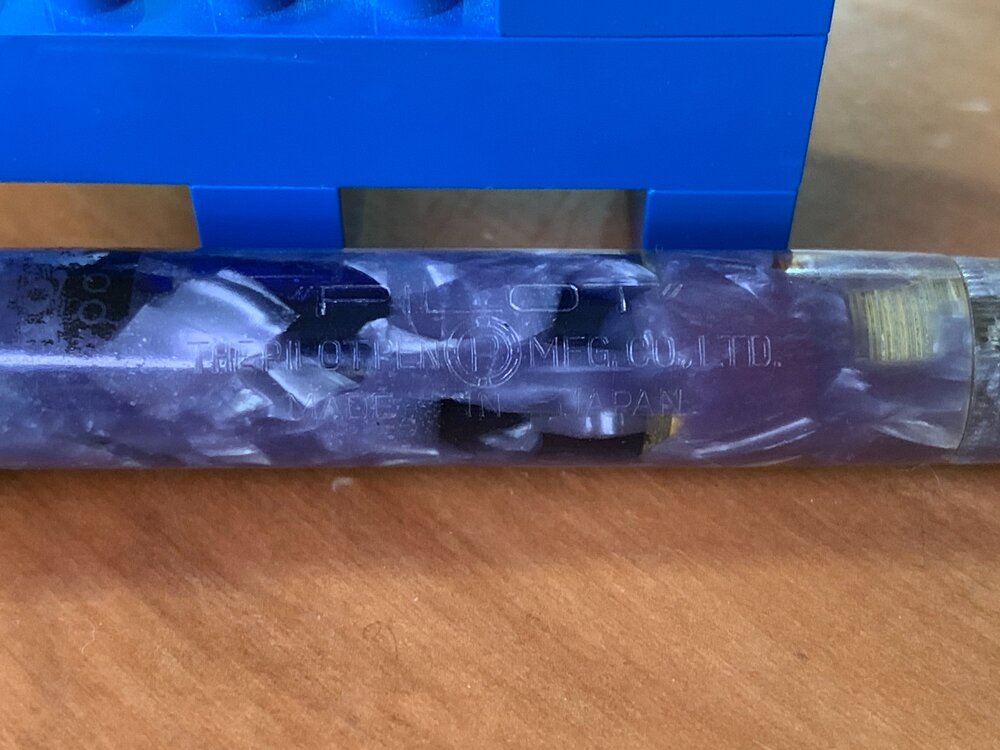Search the Community
Showing results for tags 'eyedropper'.
-
How to care for vintage Eyedropper pens
Abhishek Gulshan posted a topic in Fountain & Dip Pens - First Stop
Hey everyone, Recently, I've acquired a Maybie Todd Eye-dropper pen and would like to know more about how to care for such pens if they are being used regularly. How to fill ink in the proper way, do we need anything else like silicone grease or anything else to care for it? Thank you Regards Abhishek Gulshan- 9 replies
-
- mabietodd
- eyedropper
-
(and 1 more)
Tagged with:
-
Pen ID for this Swan Eye-dropper Fountain Pen
Abhishek Gulshan posted a topic in Mabie Todd Research/Special Interest Forum/Group
Hey everyone, Greetings! Needed a bit of help on the model the year of make for this sleek small swan eye-dropper fountain pen that I bought off ebay recently. Any help / guidance on this would be greatly appreciated. Thank you Regards Abhishek Gulshan -
The best Travel Pens for Iron Gall Inks (review and experiment)
efpen posted a topic in Fountain Pen Reviews
(This is a review of 6 fountain pens with two different filling mechanisms inked with R&K iron gall inks and their fitness for travel) I am on a personal quest to find the best travel pen for the R&K Salix and Scabiosa iron gall inks. First of all -- what is a travel pen? For me, a travel pen is a fountain pen that I am comfortable to take with me on an airplane or to put in my backpack and go on a bumpy mountain bike ride without fear of it burping or leaking ink. So far I have found two types of fountain pens that meet my travel pen requirements -- Japanese eye-droppers like Opus 88 and vacuum fillers like TWSBI vac700R, Pilot Custom 823, Asvine V126 or PenBBS 456. Both these types of pen come with a shut-off valve that, when engaged, seals off the section from the barrel minimizing the chances of ink burping or leaking, an important trait for a travel pen. For this review I chose 6 pens -- two Opus 88 (Clear Jazz with Flex EF nib and Clear Demonstrator with a regular EF nib), three TWSBI vac700R variants (regular, Iris and Kyanite, all with EF nibs) and one Asvine V126 also with an EF nib. Before going any further, a few words about the R&K iron gall inks that I used. Both Salix and Scabiosa are dry inks and all 6 pens were suffering from a dry and inconsistent ink flow out of the box (skipping, rail-roading, faint lines). I resolved this ink flow problem with the help of the White Lighting additive from vaness1938. After some trial & error experimentation I settled on adding 1 drop of White Lightning to 5ml of Salix or Scabiosa ink. This procedure resulted in a wet and consistent flow in Opus 88 and TWSBI vac700R pens. Asvine V126 flow improved too but was still not as good as the others. Instead on White Lightening one can use dish washing liquid soap (no idea about the right concentration). I have been running my experiment for about a month and am ready to present my preliminary score card. No pen has come out a perfect travel pen for the Salix or Scabiosa iron gall ink. There are pros and cons for each one of the pens. That said, here is the current leader board. The winner -- Opus 88 Jazz with Flex EF nib. Pros: Construction Quality. The pen is made like a tank with a strong and durable resin. No chance of cracking or breaking under normal use. The stainless-steel nib is the only metal part in the pen reducing chances of corrosion by acidic nature of iron gall inks. The plunger rod is made of firm plastic. No nib corrosion has been observed so far in my experiment. Shut-off valve to seal-off the ink barrel preventing ink from burping or leaking. Huge ink capacity (2.4ml for Jazz and 3.4ml for Clear Demonstrator) Ease of disassembly and cleaning. Eye droppers are designed for ease of unscrewing the section. After all this is how you refill the pen. This is particularly important when using iron gall inks that generally require more frequent cleaning/flushing than the die-based inks. Cons: the cons are more subjective and the readers may disagree: The Opus 88 are bulky. I would prefer a bit thinner body. The Opus 88 EF nibs write well but I slightly prefer the nibs in TWSBI vac700R. It is a little surprising that they write differently because both Opus 88 and vac700R use JoWo #6 (aka #12) nibs. Go figure 🙂 Close Runner Up -- TWSBI vac700R Pros: Great Writing. I like vac700R EF nib better than the similar Opus 88 EF nib. Pen Ergonomics is to my liking (thinner body than Opus 88). Large Ink Capacity of almost 2ml when filled to the brim using Pineider ink well. Shut-off valve to seal-off the ink in the barrel from the section similar to the Opus 88. Good cap design with a o-ring on the base of the section to prevent ink from drying out when the cap is closed. Cons: Construction is good but not as solid as of Opus 88. There are reports over Internet about TWSBI pens cracking problem. I have had three vac700R pens for about a year and none of them cracked yet. The blind cap's threads are plastic in direct contact with the metal threads of the vacuum mechanism. Over time metal threads will damage the plastic ones. Very quickly, after two or three refills with iron gall ink the plunger has become very stiff making vacuum filling mechanism hard to operate. It happened with all three vac700R pens I have been using. Applying silicon oil that comes with TWSBI pens is of little help. After couple of refills the plunger is stiff again. It seems that iron gall ink deposits ferrous oxide on the plunger's rubber gasket, or silicon oil is somehow negatively affected by the acid in the ink. I never had such problems with die or pigment based inks. Following Ron Z's recommendation I applied Molykote 111 silicon grease -- a thick hydrophobic substance that is supposed to be chemically inert. So far it is working better than the TWSBI silicon oil but I need more time to evaluate Molykote 111 effectiveness. This serious issue alone put TWSBI vac700R in the second place. If not for this problem vac700R would be a clear winner. The last place -- Asvine V126. Pros: The price -- at $26 on Amazon it is by far the cheapest Aesthetics of Pilot Custom 823 that Asvine V126 copied. Cons: Stiff EF nib. I do not like how it writes. Poor construction quality. The Shut-off valve does not seal properly. The pen leaked ink into the cap while on the airplane. I will be continuing my experiments and hope to provide an update in a month. -
Hey folks! I recently picked up a Kaweco Student. I love the pen very much, and it could easily be a workhorse EDC for me if I could get a bit more ink into it. Which leads us to my question: has anybody out there ACTUALLY converted their Student to an eyedropper fill, and if so what was the experience? Here's why I ask. 1) The old leaking issues with eyedropper conversion on the Sport (model-specific, or Kaweco problem?); and 2) The metal threads on the Student grip section vs. ink/erosion/conversion/etc. Since this will be an EDC if it works out, I don't want a gusher knocking around inside my bag. (And yes, I know it's plastic and it could crack etc etc, but what I'm asking is if it will hold up for reasonably gentle everyday urban school-and-home type stuff) The only thread I found on FPN that mentioned conversion at all was this old one, but it never seemed to come to any consensus, just the OP saying it worked for him for three days (I've messaged him as well). Digging up info on non-Sport Kawecos is not easy! I'm hoping somebody out there has DONE it and can...wait for it..."fill" me in? Thanks! -Steve (The Idle Expatter)
-
I won't recommend you do this, but for what it's worth, I managed to shoehorn in a Kanwrite no.8 nib on my Woodex Model 33. The pen came with a Kanwrite 5.5 nib unit threaded for JoWo, but the no.8 Kanwrite nib got in without much hassle, I don't notice any cracks in the housing, and IMO, this looks more proportioned to the grip. The pen writes flawlessly with a wet fine line, as you can see from the writings on the notebook on the backdrop. The ink for those wondering is Skylark coffee brown...👍 Have a nice day🙏
- 5 replies
-
- ebonite
- eyedropper
-
(and 2 more)
Tagged with:
-
Straight outta Shanghai, crossing vast oceans and lands, comes the latest from PENBBS, the model 487 magnetic filler eyedropper. By now, you've all read about the revival in magnetism in fountain pen filling with the likes of Piedmonte Pen Design and the PENBBS Year of the Rat 492 Well this here's the one for the masses. Same set up as the 492 but a bit more accessible to purchase and just as competent on the magnetic cap pulls magnetic piston. Goodies My first fill brings out the delightful novelty, look ma, no rods! Neato, speedo! The mechanism is very easy with the clear instruction card provided. Initially the push/pull of the piston was stiff and ChrisRap52, Douglas Rathbun, What I Ink, Inky.Rocks YouTube reviews are good for unstuckth tips by turning the piston. This thing holds a lotta ink sans rod and the magnet is plenty strong, heck you can even turn it into a deskpen Fit and finish are superb. This is my first PenBBS pen and I am very pleased beyond the mechanism, if replaced or broken, this would serve as a superlative eyedropper regardless and that is a very good thing.It posts securely but makes the pen over long and I don't post even though I'm a serial poster. Purdy - Chatoyance, pearly pearls all the way from cap to barrel. Described as brume, mist or fog in French and I had to look that up; there went the college French.Balance - this pen has "it" unposted which very few pens do for me. I love the taper and grip section, very well balanced like another fav balance, the FPR Himalaya v2 or Sheaffer ... Balance!Smoother writer - the RM, round medium has no skips and no leaks. The flow gushes with Monteverde Blue Black. Very surprised for my first PenBBS pen. Waay waay better than the (bleep) Moonman M8 dry junky nibs coming out recently Neutral This pen is long, like Cross Peerless, Pilot 743 length. But not an issue for me unposted Baddies Hard to say for only a week in of usage. There is so much good!! Well this pen does have magnets so I steer away from mechanical watches and maybe some electronics unless data scrambles from poor to nil gauss shielding. It does not stick to the titanium Conid though. Design flaw alert: Unlike the 492, the back end cap does not appear to unscrew meaning the end is not user accessible to poke a chopstick on the magnetic piston if it gets stuck. And oh boy, it done stick, stuck, stooky. I'm still on my first fill despite using it onstop daily journalling, scribbling, todoing. For fun, I tried moving the piston to dispel the empty void but no go. Argh!!! I had to syringe out the ink as my theory was the magnet is not strong enough to dispense against the feed. It did start moving again thankfully once the barrel is emptied with ink, but it shows a fatal design flaw where if the magnetic piston does get stuck at the end cap on full fill there is no way to release the piston short of a more powerful electromagnet. What I surmise is that the piston attaches to only one side and may displace at an angle if a weak push/pull attempt is made. If the piston gasket is askew from perpendicular from the inner barrel, stuck city. When I made another attempt on a full pen, the piston finally moved and jerkily burped ink successfully out the feed and onto my hand. This is definitely in need of some user practice or I'll settle for long serial fills at a time.That said, if the piston is irrevocably stuck, one still has a very competent eyedropper pen Summary Despite the non-end cap user accessibility, PenBBS 487 is a wonderful pen on its own write/right. Pretty, functional and balanced aside from its nifty novelty of filling mech.
- 12 replies
-
Review: Modified Ranga 8b This review is about my experience with a Ranga 8b fountain pen that has been my primary daily writer for about a year. I will discuss my thoughts on the pen, the experience of ordering from Ranga, and the modifications that I made to it to fit my writing needs. I won’t be assigning scores to various categories of performance; while that approach is certainly popular and useful in some contexts, I think a general discussion of my experience might be more valuable for the reader. Additionally, I won’t be discussing the stock version of the pen very much. So, if you need information on size and other specifics, one of the many other reviews of this pen is probably a better source of information. The Ranga 8b is an artisan made pen, manufactured in Thiruvallur, near Chennai / Madras India; like many high-quality pens from the region, it has been hand turned from an ebonite rod. I ordered my pen in a brushed mat black finish. I truly appreciate handmade, high-quality writing instruments that small makers like Ranga produce. Ranga is not attempting to sell a brand name nor do they really have a marketing department. They only have the promise of making well-made pen that truly fits your needs. I ordered the pen directly from their website at https://rangapens.com/ I found Ranga to be particularly responsive in their communication. After placing my order, I was contacted by the company to confirm my preferences and to give me updates about when it was being made and shipped. It took roughly a week for my pen to be manufactured, shipped and delivered to my home in California. General Thoughts on the Ranga 8b Much has been written about the Ranga 8b pen model, so my experience is not unique and probably confirms most of its positive accolades. The pen itself is beautiful and is very well finished. Most users enjoy the long, hourglass shaped section, and indeed I can confirm that it is my most comfortable pen to write with, in part because of this feature. The shape and balance of the pen in stock form is amazing, especially if you use it unposted. The pen simply feels luxurious, and when I received it, I knew that I would not have to search out a high priced “grail pen” to get what I was looking for in terms of a writing experience. My Pen and the Modifications I Made I opted to get the eyedropper model, because it gives me a lot of control in setting up the pen. I write on thick paper (Clairefontaine notebooks and HP32 inkjet paper) and I prefer pens with a generous ink flow. I also find that I much prefer ebonite feeds – they seem to be more consistent in delivering a wet line. And as a material for the pen body and section, I enjoy ebonite because it does not get slick if my hands get sweaty, and because I can make small alterations to the shape of the pen if needed. The pen came with a high quality Kanwrite nib with Ranga engraving, and a simple ebonite feed; the nib and the feed are friction fit into the section. I ordered a medium, which I use most of the time. However, I also have another Kanwrite nib that can fit this pen, which I ground down to a stubbish left oblique (the red cursive in one of the photos was written with this nib, though in another pen at the time). The first change I made to the pen was to replace the feed. The stock feed was reliable, but it was not quite providing a generous enough ink flow. After adjusting it a few times, I opted to replace it with a high quality Kanwrite 6.3mm ebonite feed from Fountain Pen Revolution. At the same time, I also opted to recess the nib, because I wanted it to be slightly shorter. I pushed the nib and feed into the section a bit further than normal, and heat set the section to this nib and feed using boiling water. In other words, I submerged the section in hot water and shaped it around the nib and feed to ensure proper fit – yet another advantage of ebonite. Afterward, I submerged just the nib and feed to heat set them to ensure proper ink flow. Thus, the nib on the pen is set further within than stock, and after heat setting (section and nib/feed), I have no issues with ink leakage. The second major change I made to the pen was to create an added taper toward the back of the pen body. In some ways, it resembles a less dramatic mid-body taper of the kind found on the Franklin Christoph Model 2 Intrinsic. The stock pen posted securely, but not deeply; it was a bit long for me. And while I enjoyed it, even while posted, I wanted to improve the balance of the pen. I used a very sharp knife to shave off material starting at about two thirds of the way towards to end of the pen. Next, I used a sanding sponge, 80 grit, to remove the marks from this process, so that the finish matched the original brushed, mat ebonite. In hindsight, I probably should have used only the sanding sponge. It was probably sufficient for the job and by using a knife I introduced flaws into the pen that you can see if you look closely. That said, this modification worked wonderfully. My pen now posts fully and deeply, and its balance is perfect for my hand. This modification meant that instead of using the pen periodically, it has become my main pen for everyday work; I barely put it down. Final Thoughts The pen is my ideal writing instrument, and certainly the most comfortable I have ever used. The only time I do not use it is when I need to write in direct sunlight, or to use thin, cheap paper, such as when I grade student work (I am a history teacher). For these tasks I use a cartridge converter pen instead of an eyedropper. Much is sometimes made of using an eyedropper pen for everyday use, and I am not sure I have much to add on the subject. I have for years used an eyedropper every day, with few if any problems, as do thousands of other people. Doing so takes some knowledge and patience, so as they say, your mileage may vary. I will be ordering another Ranga 8b pen, even if it is just to have one in reserve. This pen is by a large measure is my favorite. That said, since I prefer to post this pen, I will ask for my next one to be made with a slight taper towards the end to facilitate deep posting. I think that this ability to customize an order, combined with receiving a very high-quality product for a reasonable price, is one of the major advantages of ordering from a small artisan like Ranga. Needless to say, I am a very satisfied customer, who is just trying to spread the word. If I were to order this pen again for the first time, I would probably purchase the stock version, to see if I would prefer to use it posted or unposted. I obviously liked it enough to take the time to modify it, rather than simply buying a new pen, which I think speaks to its appeal.
- 10 replies
-
- ranga 8b
- indian pens
-
(and 3 more)
Tagged with:
-
From the album: OldTravelingShoe's Random Pics of European Fountain Pens
© (c) 2022 by OldTravelingShoe
- 0 B
- x
-
From the album: OldTravelingShoe's Random Pics of European Fountain Pens
© (c) 2022 by OldTravelingShoe
- 0 B
- x
-
From the album: OldTravelingShoe's Random Pics of European Fountain Pens
© (c) 2022 by OldTravelingShoe
- 0 B
- x
-
Not much is known about this company. We know that Wilson Pen Company was one of the significant pen manufacturers in India. They existed since 1939 as Wilson. They were headquartered in Bombay, India. (I learnt somewhere that they named their company Wilson, because the nibs they imported from USA during wartime had Wilson mentioned). During my school days, I remember Wilson was an envious brand. They used to come in many many models, introduced frequently and often high class replicates of famous Parker models. The most famous were the Wilson jotter pens & also a ball-point pen called "4-point pen" (used to write in 4 colours) Wilson actually paved the way to many western name brands in India like Kingson, Diplomat, Artex etc. They used to come in a plastic boxes mostly as pen sets. The boxes resembled & also open like the present day, manual mercury based "blood pressure monitoring" instrument. I had many Wilson pens but by now have lost all of them, but the pens were always in my mind. Recently, a friend of mine told me that he had a Wilson Fountain Pen, which he never used, since he fancied ball-points only. Thus came to my hands this beautiful Wilson 21, a deep red colour pen, with gold-plated clip and a cap band. (resembles vintage Parker) The pen posted The etching in the barrel "Wilson Regd" & 21 The Cap with clip & Band, "Wilson" is inscribed in both places. The Nib..Here to "Wilson" is written in nib, feed & Section Hope you liked reading about Wilson 21...
- 11 replies
-
Modifying Airmail 69t and 71JT with a new plastic feed
Avishek posted a topic in India & Subcontinent (Asia)
I have been wondering whether Airmail 69t and 71 jt can be fitted with a plastic feed that comes with Kanwrite desire, Jinhao X750/x450 or Pierre Cardin President. I was thinking this because Sheaffer's NN feeds are unavailable and the plastic feed of the above mentioned pens have good number fins to prevent burping of 69t or 71jt . If this modification is successful then NN's feed unavailability problem would be easily solved. -
Hi everyone! I received a lot of old Japanese fountain pens that appear to be old plunger fillers, all of which appear to need new seals as they do not vacuum in any ink (the pen pictured leaked from the blind cap end when I syringed some water into the body). The blind cap unscrews, but the plunger has no resistance when pulled up and can be shifted around to various angles. I can see inside the pen with the section removed that there is a small bulb attached to the end of the rod with a small rubber washer not too far behind it. I did some looking around but had trouble finding a lot of information regarding how to fix these types of pens. Any help would be greatly appreciated! P.S. If anyone knows anything about what this pen is, I'd appreciate any help identifying it. The label reads "shiruba" or Silver
- 19 replies
-
RANGA HANDMADE PENS -HAPPY NEW YEAR 2022 -BAMBOO (THIN /REGULAR /GIANT SIZE) SERIES - OFFER PRICE
mpkandan posted a topic in Market Watch
Dear FPN'ers, Ranga Handmade Pens wishes you Very happy, healthy and prosperous New Year!!!! This Offer is for RANGA Handmade Pens Bamboo, Thin Bamboo and Giant Bamboo Model in Classic Ebonites and alluring Acrylics .This is Japanese Style Pen with extensive craftsmanship. It is unique writing instrument with carrying lot of Art. Ebonite is highly beautiful , Durable, evergreen ,long lasting , Classic and favorite material for Pen lovers. It has Vintage Characteristics. Premium Acrylics are very attractive ,looks Gorgeous and appeals Visually very much. Bamboo and Giant Bamboo caps in less than 1 turn. Thin Bamboo Caps in 2-3 turns Bamboo Dimension: Capped Length - Approximately 6 Inches Cap Dia - 16mm, Barrel Dia - 16mm, Section Dia - 12.5mm at Thickest part and 11mm at thinnest part. Thin Bamboo Dimension: Capped Length - Approximately 5.75 Inches Cap Dia - 14.5mm, Barrel Dia - 14.5mm, Section Dia - 11mm at Thickest part and 10mm at thinnest part. Giant Bamboo Dimension: Capped Length - Approximately 7 Inches Cap Dia - 19mm /17.5mm dia based on availability, Barrel Dia - 19mm /17.5mm dia based on availability.Section Dia - 14.3mm at Thickest part and 12.5mm at thinnest part. Making Time : 2 -3 weeks Price: 1. Base Price for Ranga Regular Bamboo Pens with Ranga Screw in nibs and German Converters: Premium Ebonite & Premium Acrylic :85USD,Regular Ebonite & Regular Acrylic: 75USD, 2.Base Price for Ranga Giant Bamboo Pens with Ranga Screw in nibs and German Converters: Premium Ebonite & Premium Acrylic :105USD,Regular Ebonite & Regular Acylic : 85USD 3 Base Price for Ranga Thin Bamboo Pens with Ranga Screw in nibs and German Converters: Premium Ebonite & Premium Acrylic :80USD,Regular Ebonite & Regular Acrylic: 70USD, . You can upgrade it to plenty of nib choices with extra charge Shipping charges: Through Courier (Quicker delivery-4 to 9 days) .USA : 19USD, Central Europe : 15USD, Singapore/ Malaysia: 15USD. Rest of the world: It varies from country to country from 15USD -19USD. Kindly note that Shipping charges are very high, we bear the 50% of shipping charge and collecting the rest from customers. (Charges published above) Payment Details : Paypal id mpkandan@gmail.com .This offer Price is Valid till 31-January-22 To book your pen, Please fill the below form . all details are included in the form https://docs.google.com/forms/d/e/1FAIpQLSc0o_xxc0vrLXV27Wvp1FRvnH-qDbBVl8_1WgD50g3xb4DsyA/viewform?vc=0&c=0&w=1&flr=0 Take care Regards, Kandan.M.P Ranga Pen Company -
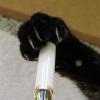
Danitrio Mikado eyedropper pen leaked-a comparison with a Namiki Emperor
jandrese posted a topic in Japan - Asia
One of my Danitrio Mikado (eyedropper filling model) pens leaked on me at work. That is Noodler’s Navy you see on the section in the first image. I collect Danitrio and this sort of thing happens more often than I care to admit on their eyedropper filling pens. I still collect Danitrio but stopped buying eyedropper models a couple of years ago. At this point I know all the potential ways in which a Danitrio can leak. This one leaked at the junction between the section and the barrel. Naturally, with a leak like this you don’t know it’s happening until you look at your inky hand so that’s nice. There is no obvious reason for the leak, which led me to investigate further. To do so I thought a comparison to a Japanese eyedropping pen that has never leaked on me was in order. Thus, I cleaned out the Namiki Emperor I had with me at work and set about comparing the two pens. What have I learned? 1) That even compared to a Namiki Emperor the Danitrio Mikado is a big pen and looks great. Feels good to hold and to write with and that stub nib is extra nice. Seems to be on par with the Namiki on looks and feel but… 2) The section engineering and machining execution is different between the two pens. The concept is the same—eyedropper with shutoff valve—but the Namiki has some advantages. a. The Namiki threads are finer pitched and better machined inside the barrel and on the section. This can be felt when screwing in the section; there is a smoother feel and less play. b. The threaded portion of the section has a bigger diameter on the Namiki. The overall diameter is 10% greater and but the ratio between the diameter of the grip portion and the threading is also 10% greater on the Namiki. c. The o-ring on the Namiki is more precisely seated, that is, it has no room to move about. d. Both o-rings fit into a slot in the barrel that is flat and smooth before the threads start up. The slot on the Namiki is not as deep. I have a gang of Danitrio pens that fill by eyedropper. One or two have never leaked on me at the section. This pen used to be one of them. The problem is at the level of the o-ring. There is too much potential for the o-ring to move about, get twisted, or otherwise compressed in an uneven fashion. It only takes an infinitesimal gap for ink to leak. Water always finds the path of least resistance. A little side pressure from your grip and the heat from your hand is all it takes to set the leak in action. Part of loving Danitrio seems to be leak mitigation. Changing o-rings has helped in the past on other pens but o-rings that fit are not easy to come by. Danitrio themselves does not seem to have consistently sized, readily available replacement o-rings. That bit about consistently sized o-rings may make more sense knowing that there is more variability between Danitrio pens of the same model than Namiki pens of the same model. I reckon Namiki buys only one size of o-ring that always fits like it is supposed to. I admit that it all is a bit frustrating, but I press on. IMG_8517 by Ja Ja, on Flickr IMG_8529 by Ja Ja, on Flickr IMG_8535 by Ja Ja, on Flickr IMG_8539 by Ja Ja, on Flickr IMG_8541 by Ja Ja, on Flickr IMG_8543 by Ja Ja, on Flickr -
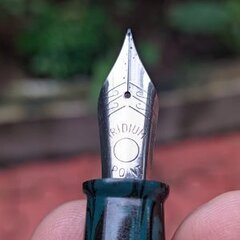
Kanwrite Apex... A inexpensive introduction to the eyedropper world
Aravind_A_2310 posted a topic in India & Subcontinent (Asia)
If you're into fountain pens, chances are you know who Kanwrite is. They're the largest nib manufacturer in India and their models like the desire and heritage have garnered critical acclaim all over the world. They also (allegedly) make some of Noodler's pens as well. But that's not all the models they make. They make some pretty good inexpensive pens as well... some of which are a good choice for students and beginners who would like to start their fountain pen journey. Today I'm going to look at Kanwrite's cheapest offering, the Apex. A simple eyedropper pen that can be found at about ₹60 - 100/- INR(less than $1-2 USD) in India. And for the TL;DR of it, it's a pen that, if you want a good beginner pen or you want to venture into the world of eyedropper pens, this is a good place to start. So, let's crack on... Design and Build This is the cheapest pen that Kanwrite offers, and you can tell... not necessarily on the build quality, but you can tell why they chose to go with an eyedropper for this, you're basically paying for the nib, feed and a plastic housing. But beauty lies in simplicity... right? For the minimal amount of materials used the pen looks and feels solid. Even though it's at the bottom of the barrel compared to other Kanwrites, ink it up and it has the same amount of character and appeal as other fountain pens. They have various tints for the plastic, but I went for the demonstrator look because, well... I'm a sucker for those. The pen is made of the same plastic that is called a "celluloid derivative" by Mr.Nathan Tardif himself, and yes... it has the smell, but not that much compared to other pens that I have that's made of the same material(lookin' at you... Kanwrite PC converter). and yes... it can handle drops like a ballpoint... I accidentally dropped it back side down about 3ft from the ground, and aside from a temporary ink fountain that covered my floor with purple ink, the pen wrote as soon as I picked it up and put It on paper(probably because the fall helped prime the feed even more). The cap is a simple screw in cap that takes around 2 turns to open/close. and the clip is sufficiently tight yet easy to clip into even thick fabrics. it also has Kanwrite stamped on it, alongside the heat embossed Kanwrite logo in the barrel. Overall for a ₹60/- pen, it looks distinctive, and that's good in my books. The only issue is that the pen has minor flashing marks on the inside of the section, probably due to not properly trimming the injection molded parts, but other than that, a solid pen that is well built. As for size, well... it's a small pen... From left to right: Kanwrite Relik Jinhao X450 Airmail/Wality 71JB(cartridge converter system) Kanwrite Desire Kanwrite Apex Nib, Feed and Writing Experience Kanwrite is a company Known for their nibs, so it shouldn't be a surprise that this one will also be a good nib, right? Well, we'll get to that in a bit. Let's first take a look at the nib, shall we? The nib is a Kanwrite No.00 stell nib in fine. The same nib that is used in the Relik and perhaps even the same size as in the Airmail 77 and Camlin 47. It's a tiny fella, and couple that with an ebonite feed that is sufficiently finned, and you can rest assure that reliability will be a strong suit of this pen... and it is. I have never run into any dry out issues even when left uncapped for the better part of an hour. So suffice to say, it's a reliable writer. Talking about how it feels while writing, well, the pen is a small guy. But even for me, a guy with a hand the shape of a kayak(slim and long...) writing it unposted was fine, but I'd still recommend posting it as then it's in my opinion a perfect size for writing with. Talking about writing, and well... It writes just like a Kanwrite. Very smooth for the most part with a hint of a feedback. It's less than you get while writing with a pencil but you feel that you are writing. This is with TNPL 70gsm copier paper though. Move on to a better paper like a Classmate or Rhodia, and the nib just glides... honestly, as much as the Airmail 69T that I shoehorned a Kanwrite No.35 nib into(Check that one out here). And I'm baffled that you can get this writing experience out of a pen that costs around the same as a ghee roast in a restaurant. Now the pen is an eyedropper and does take around 2ml of ink. And like most eyedroppers it does burp, but when the barrel is so low that you are not refilling the pen out of pure ignorance and laziness. So, refill it when the ink gets to about 1/8th mark, which'll last you more than 2-3 ballpoints. Plus, everything is friction fit, so it is easy to clean. Before getting into the conclusion here's a writing sample of this pen. Conclusion and Final verdict Honestly, there isn't much to say about it, if you have a Kanwrite PC, Saloon, Relik or any of the lower end ones, the experience is somewhat similar. and for just 60 rupees, you can't go wrong. Like I said in the beginning it's a pen that, if you want a good beginner pen or you want to venture into the world of eyedropper pens, this is a good place to start. It is a cheap and effective gateway drug into the world of fountain pen. couple this with a ₹25/- bottle of bril blue, and you're pretty much set for at least half a year, or more. Thanks for reading my write up and I'll see you around...- 7 replies
-
- kanwrite
- eyedropper
-
(and 4 more)
Tagged with:
-

Airmail 69T with Kanwrite Nib Swap... Why didn't They Made It Like This!!!???
Aravind_A_2310 posted a topic in India & Subcontinent (Asia)
I was perusing through the fountainpen forums the other day and came across @mehandiratta's review of the Airmail 71JT. He described how the pen was magnificent, but the nib it came with was a mess... literally, as it burped on first write... and he then swapped with a No.35(International #6 for anyone wondering) nib and now it's his daily writer. I was so astonished by the fact that you can swap a no.35 nib on an airmail pen which usually takes No.8(a stubbier version of a #6) nib. So being the curious and idiotic imbecile that I was, I started to find out how to fit a No.35 nib to my pen... Forgetting the fact that my pen is the smaller 69T instead of the 71JT(Which literally means Jumbo Transparent) that I bought from The Pen Hospital in my city (Thrissur) a while ago. At first I was surprised that the nib didn't fit as the diameter for No.8 and No.35 feed was identical... while I found a way to coax it in there, the cap wouldn't close properly... after about two days I got frustrated and abandoned the idea and planned to buy a 71JT... but then... While I was watching youtube, a channel called Penatomy appeared in my feed and I saw that he was able to fit a Kanwrite No.35 nib in an Airmail 69T... and I got my guts back... And I watched the video and found out that evenly scraping off the ebonite feed bit by bit until the nib fits in place... and voila... a No.35 nib on a 69T... And I have so much to say about it... Design And Build To be frank... this is one of the most beautiful budget pens I have (given that my pen collection only contains pens under ₹800/- at least for now). And it's the blend of a simple clear acrylic barrel that is hand turned with the randomness of the pattern of the plastic cap (that is made of the vegetal resin and it smells... but not as strongly as the converter in the Kanwrite PC was check that one here.), the chromed finish of the cap band and the simple clip to the clear crystal like portion on the back end... all come together to make a timeless and handsome looking fella... The build is also... for the price... reasonable. Yes you won't get the heft and the metallic build of a Jinhao... but this is an eyedropper pen and if it were made of metal... then it would have not been an airmail/wality wouldn't it (at least in my opinion). The pen is long enough to hold comfortably unposted and it's light enough to write without any fatigue for a long time... Posting it though... unless you have gorilla sized hands... don't use it posted... I have a very thin and long hands (like a canoe oar... if you will) and for me unposted is the way to go... and you might find the backweight a little too much when posted... The only sort of complaint that I have in regards to the looks is that for a pen with chrome trims, it comes with a sorta gold, sorta bronze type of plated steel nib (the nib shown above), and I'd rather have it a un-plated steel nib... thankfully the Kanwrite nib fixes that for me...(the picture shown below is of a Kanwrite No.8 swap that I did before I ventured into a No.35 swap)... As for size comparison here it is next to: Kanwrite Desire Hero 336 Pilot Hi-Techpoint V7(That I eyedropper converted) Nib, Inking And Writing As I mentioned, the standard 69T comes with a No.8 Steel Airmail nib... And I might have been one of the lucky ones from what I hear about Wality nibs because at first it was a bit on the toothy side, but a little polishing fixed that... to some extent... it had a bit of scratchiness in the leftward strokes and I wasn't experienced enough at the time to remedy it, so I bought a No.8 kanwrite nib and wrote with that for a short time... and it worked. Well... Kind of... You see... Since it is an eyedropper, I was expecting some burping... but not when the ink is 7/8th of the barrel... and that issue pertained with both No.8 nibs... I then read about heat setting the ebonite feed... and that worked to an extent... but still about half full before the pen starts to burp is a bit too early in my opinion... So as per the intro, I started to try and fit the No.35 nib into the 69T. And suffice to say that I shoehorned it in there is an understatement It took a lot of trial and error but after bit by bit sanding off the feed, I was able to fit the nib deep enough that the cap can open/close in 2 turns... which was enough for me and that is how much the cap turned to open/close initially. But was all that trouble worth it? In short... Yes... The nib I fitted was a Kanwrite No.35 Fine nib in a steel finish... and I think it suits the pen better than the No.8 nibs that Airmail uses. that extra flare in the shoulder and the increased length really sets the proportions right for me... And when we come to the writing... Fine and smooth with a hint of feedback... Just the way I like it because it allows me to write fast enough without being too fast that my hand gets out of control... so I prefer pens with a slight feedback. But the feedback isn't intrusive and the pen just glides along the page. And remember, the amount of feedback depends on the paper used as well. On standard 70gsm copier paper like the one used in the writing test, the writing feels more pencil like. But if used in a higher quality paper like a Classmate or Rhodia, the feedback becomes, near as makes no difference, unnoticeable and the nib just glides over the page while putting on a generous, wet, fine line. The line is fine by western standards and a medium when compared to nibs like that from Pilot. But suffice to say that this is an upgrade that you should do. and with proper heat setting of the feed, there is absolutely no burping until the ink gets critically low, and by that time I would've refilled it anyway... All of these combined made my Airmail from never carry to daily carry. And for me, that's a win. Conclusion To conclude this for about ₹400-450/- for the pen and about ₹75/- for the nib which overall costs around ₹500-530/-(around $8 USD) this is a pen that punches way above it's weight and is a recommend from me... if you are not feeling that adventurous then a No.8 nib swap from Kanwrite can make you love your airmail even more... Trust me, if you have a Airmail/Wality 69/71 series,and you want to have an enhanced writing experience (and you're a bit frugal like me), don't buy another pen... just swap the nib with a better one. Your love for that pen will be enhanced... Just like my love for my 69T- 16 replies
-
- airmail
- indianfountainpen
-
(and 3 more)
Tagged with:
-
Opus 88 Multi-Review Taiwanese company Opus 88 has recently put out a whole series of dedicated eyedropper-filled pens, and I picked up three of them: the Koloro, the Picnic, and the Fantasia. I think these three models are similar enough to warrant a combined review. http://zobeid.zapto.org/image/pens/opus_88/picnic_koloro_fantasia_uncapped.jpg At the time of writing this, I found both the Picnic and Fantasia on sale — possibly closeout sale. I’m not sure, but it seems that these models may be discontinued while Opus 88 focus on the Koloro, the Demonstrator and the Omar. A Demonstrator might possibly be in my future, but that is not for today. Presentation They all come in a presentation box which is made from cardboard with a black vinyl covering, embossed printing and a magnetic latch. There’s a thin cardboard sleeve to go around the box and keep it closed while being shipped or stored, and there’s a foam insert to protect the contents. When I opened one of these boxes, I thought for a moment the pen was missing! It had, in fact, slipped underneath the insert while being jostled around by the mail service. Personally, I favor smaller boxes with less wasted space (like the presentation cases vintage pens used to come in), but I know the entire pen industry is against me on this, so I guess there’s no point in complaining. http://zobeid.zapto.org/image/pens/opus_88/fantasia_in_box.jpg A little cartoon pamphlet with one side in English and the other in Chinese shows how to fill the pen. You should probably look it over, as there’s a good chance you haven’t had any pens before that work like this. Or else, you can follow my instructions below. All three pens came with a glass eyedropper, although the exact size and design varied a bit. It’s just a little glass pipette with a rubber bulb at one end, and I personally don’t consider it the most ideal tool for the job (more on that below), but it’ll work. The Filling System Well, the filling system is what really makes the Opus 88 line stand out. We’ve got some FPNers converting cartridge/converter pens to eyedropper fill, but most of us don’t have much experience with the purpose-designed “Japanese” eyedropper system and its shutoff valve. The fill process is as follows: Holding the body upright (nib pointed up), unscrew the section and body in the same manner as opening a cartridge/converter pen. Use an eyedropper or syringe to transfer ink from your bottle to the pen body. Screw the section and body back together. http://zobeid.zapto.org/image/pens/opus_88/koloro_and_syringe.jpg Couldn’t be easier. There are a few quirks you need to consider, though. The knob (not really a blind cap) at the tail of the pen controls the shutoff valve. Some of you may already be familiar with a similar shutoff valve used on some (but not all) vacuum-filling pens, such as the TWSBI Vac 700 or the Pilot Custom 823. Its purpose is to prevent ink from “burping” out of the pen due to changes in air pressure (such as when flying or riding an elevator), or when your hand warms the air inside the pen, causing it to expand, and it also reduces the chances of ink being slung or knocked out of the pen during travel. Contrary to what some have assumed, you do not need to open the shutoff valve to fill the pen. You also don’t need to open it for jotting brief notes, as there is a tiny ink chamber available when the valve is closed, but you will need to open it for more extended writing sessions. The shutoff knob has another useful function that I haven’t seen mentioned elsewhere. Although there is no piston or plunger in this pen, moving the knob and rod in and out does displace a small amount of ink or air, and it can be used to pump a drop of ink into the feed. If you’ve just filled a dry pen, and you need to prime the feed and get ink flowing, this is the easiest way to do it. I’ve struggled sometimes with cartridge pens, getting a dry pen with a fresh cartridge to start writing. That shouldn’t ever be a problem here. Do be careful, though, as you can burp or spatter a drop of ink out of the pen if you manipulate the rod too much! A few minutes of practice with this technique should serve you well. Watch closely and you’ll see the ink flow into and saturate the feed. As already mentioned, the glass eyedropper will do an okay job of filling the pen. However, it doesn’t pick up much ink per squeeze, so you will be going back-and-forth between the bottle and your pen a few times. Also, the tip of the eyedropper is sort of bulbous and doesn’t deposit ink with great neatness or precision. Luckily, there is an alternative. From the Goulet store I picked up a couple of semi-disposable syringes, 2 for $5. These are what I think of as “hummingbird” syringes due to their long, blunt needle. They are graduated up to 5 ml, and they are ideal for taking every last drop from an ink bottle and then putting that ink precisely where you want it, as well as seeing exactly how much you got. They have other uses, such as refilling cartridges, but they really shine for filling eyedropper pens such as these Opus 88s. Maintenance Because these pens open up for filling, and because they use interchangeable nib modules that simply screw in and out, and because there’s no complex filling mechanism, these pens should be easy to maintain, to clean, to assemble and disassemble. One quibble is that the tail end of the pen can’t be disassembled as easily as, for example, a TWSBI. To remove the shutoff valve mechanism requires a special spanner wrench that Opus 88 neglected to supply with the pens. Likewise, if the walls of the ink reservoir pick up any residue, you can’t simply stick a Q-tip in there and wipe it off, since the shutoff valve is in the way. (I’d suggest not using Baystate Blue in these!) Also, much like TWSBIs, these Opus 88s rely on O-ring seals in several different places. Some of these are easy to see and access, some not. All of them could benefit from a little lubricant, but none of them came with any. In fact, the shutoff knobs on some of these pens squeak-squeak-squeaked when I operated them. The O-rings on the valve itself and where the section and body go together also felt sticky. I really wish that Opus 88 had included a little vial of silicone oil, such as you get with TWSBI pens. Luckily, I had both silicone oil and grease on hand. If you don’t, you might consider picking some up when you order any of these pens. Please do not try to substitute any random oil or grease that you may have! Petroleum-based lubricants can damage O-rings. That means no Vaseline, no Lubriplate or M1 Rifle Grease, no WD-40 or Break Free, no 4-in-1 Oil, etc. If you can’t get actual silicone grease or oil, then Super Lube synthetic grease or Crosman Pellgunoil should be safe substitutes. http://zobeid.zapto.org/image/pens/opus_88/koloro_and_lubricants.jpg I lubricated the valve operating rod, the body-and-section seal, the tiny O-ring at the base of the feed housing (more on that later) and the valve itself. The squeaking and stiffness went away. I applied some extra grease to the section threads and to the cap threads, just to provide a little extra smoothness and sealing for ink and air. All three of these pens hold roughly 2 ml of ink. In fact, if I stop filling just short of the section threads, which I think is good practice, then the total is just short of 2 ml. When you see claims that eyedropper pens hold “a ton of ink”, let's put that in perspective and remember that a Sheaffer Skrip cartridge is supposed to come from the factory with one ml, and a Lamy 2000 holds about the same. Two ml is a very healthy amount, hyperbole not needed. Design & Construction I'll say right up front: These are well made pens. Parts are well-fitted; there are no gaps or rough edges. Machine work and threading is very clean. Surfaces are nicely polished. Most of all, they're made from two of the most time-tested of all pen materials: ebonite and acrylic. All of the pen bodies and sections are made from translucent acrylic. The Koloro and the Fantasia both have shutoff knobs made of ebonite. The Fantasia’s cap is made from ebonite, and the Koloro’s cap is made from a combination of ebonite and acrylic parts. I think the Koloro and Fantasia would look and feel a bit nicer if their sections were ebonite too, but that's not a big deal. A natural point of comparison might be that other Taiwanese company: TWSBI. Opus 88s are a fair bit more expensive than TWBSIs, but the materials and construction are markedly better and, I think, hold up well to US brands such as Bexley, Edison or Franklin-Christoph. Those pens don’t break, and I don’t expect Opus 88s to break either. The translucent acrylic body is a great match for an eyedropper pen, since it allows you to easily monitor your ink supply. However, it’s easier in some cases than others. The body of my Fantasia is quite dark brown. When filled with a wet ink that coats the sides of the reservoir (like for example, Diamine Eclipse), it's difficult to gauge the ink level. I have to hold it up to the light, wait a minute for the ink to “settle,” and squint. Frankly, it's easier to keep track of the ink in a C/C pen. With the Picnic it's just the opposite; the pen body is a pale blue, and with a dry ink (like OS Accident) it’s easy to glance and see the ink sloshing around. The Koloro falls somewhere in between, as I can't tell at a glance, but I can hold it up to the light and discern the ink level pretty easily. I have to emphasize that this depends on both the darkness of your chosen body color and the ink you’ve put in. The Koloro was the first of these pens that I bought, and the distinctive two-tone look is part of what attracted me. It’s a clean and modern design, and this beige-and-gray color combo has proven popular. However… In the catalog photos online, the body color looked almost green, like a lovely teal. Some sellers even described it as a beige-and-green. The one I got looks darker and much more neutral gray than those photos. I'd call it "smoke gray". Were the online photos deceptive, or did Opus 88 change the color at some point during production? I would have preferred one that looks like the photos, but it's still an attractive pen. http://zobeid.zapto.org/image/pens/opus_88/size_comparison.jpg The Koloro and Picnic are full-sized pens. Capped, both pens are about 14.4 cm (5⅛”). Both are comfortable to use un-posted, and both of them post “okay” but not great. Either of these can fit neatly into the pen loop in my vest, but wouldn't go if they were any longer or fatter. Obviously, your pen loop may be different from mine, but what I'm saying is that these are about the very largest pens that I'd normally consider carrying away from home. The Fantasia is similar in girth, but shorter, giving it a chunky look. Capped, it’s about 11.7 cm (4⅝"), making it the shortest modern pen in my collection. Uncapped, it’s about 10.3 cm (4"). As a result, I can write with it un-posted, but the very tail of the pen rubs lightly on the web of my hand. For extended writing I would definitely post it, and allowance has been made for this. The tail of the pen has threads for posting. That seems to work very well. However, if you post the cap and then find you have to open the shutoff valve, even more screwing around is going to be needed. The neurotic among us should be aware that the Fantasia’s pocket clip may or may not line up with the nib when posted. On mine it does. The cap finial seems very tightly secured, and I’m not sure if it’s even supposed to be removed or loosened (which would allow repositioning the clip). There is a little leeway to turn the nib assembly, though, if you really care that much. I should also note that the Fantasia section is stubby, and gripping it will result in some finger contact with the cap threads, but this didn’t present any comfort problem to me when writing. If you are particularly sensitive to this issue, you might want to go for the other models with more normal grip style. The color and style of the Fantasia is quite compelling to me. It stands out, and to my eyes it has a sort of 1970s retro vibe. As already mentioned, the Koloro is another pen with distinctive style. The Picnic is plainer and less distinctive, since it has no decorative ebonite bits, and there are any number of other translucent and cigar-shaped pens on the market. That’s not to say it’s bad looking at all. Screw Caps These pens all have screw caps, which is something I wouldn’t usually even comment on, but I’ve seen some complaints about how many turns it takes to uncap them. So, let’s take a look at that: Opus 88 Koloro — 3½ full turns Opus 88 Picnic — 2 full turns Opus 88 Fantasia — 2½ full turnsI checked some other pens, vintage and modern, and it seems like they typically require around one or two full turns. So, the Opus 88s do require a little more. To me this is trivial; even with the Koloro it slows me down by only a small fraction of a second. Some other folks, apparently, find it highly annoying. I do believe that more threads make for a more secure and more airtight cap, for whatever that’s worth. The Nibs All of these three pens come with standard #5 sized nib-and-feed modules and steel Jowo nibs. (The Demonstrator and Omar come with #6 size nibs, though.) I won’t go into great detail about their writing qualities, since they are basically the same as nibs shipped in TWSBIs and many other brands, and they are widely known to be good quality. All three of these were fine tips and wrote well right out of the box. They were adjusted slightly dry, which I've also found to be typical of modern German nibs, but increasing flow is one of the easiest adjustments to make on a steel nib. They do incorporate a nib-feed-and-housing module that is interchangeable with some other brands — but I don’t know which ones! Digging through my parts box, I found a nib assembly with a Bock nib that swapped right in, but I don’t remember where it came from. If anybody else familiar with these pens knows which other brands it can swap with, please say in the comments! When removing the module, you must be careful of the little O-ring right at the base of it, a place where I’ve never seen one used in any other pens. You don’t want this to fall out and get lost. I believe this is supposed to keep ink from going between the feed housing and the section, which wouldn’t cause any harm but can look messy in these transparent, demonstrator-like pens. (I also found that when flushing the feed with a syringe, too much pressure can force water past this O-ring and into the section, which again looks a bit messy.) You don’t have to swap whole modules, though. Bare #5 nibs can be swapped between assemblies with only a little more work and care. Since I wanted a bigger tip with more flow, I swapped a TWSBI medium nib into the Picnic, and it works with no problem. Value & Conclusion If you favor the Japanese eyedropper filling system or just want to give it a spin, these Opus 88s are pretty much your only option now. Nobody else is doing this, while Opus 88 are doing it quite well. For those who are less concerned with the filling system, the value calculation is more complicated. Their prices are in the mid-range: a fair bit above Monteverde or Conklin, a fair bit below Edison or Bexley. My personal evaluation of Opus 88’s quality is closer to Bexley than to Monteverde, so it seems like a pretty good deal to me. And of course, I have to compare with TWSBI. There’s a bit of family resemblance between the products of these two Taiwanese companies: lots of transparent or translucent pens, lavish use of O-rings (unusual among other brands), novel filling methods with large ink capacity, easy disassembly (for the most part), and the use of standard, interchangeable, German nibs. The Picnic is priced much higher than the Diamond 580, and the Demonstrator much higher than the Vac 700R. However, TWSBIs are made of injection-molded polycarbonate and are known to crack, and break, and break again. The Opus 88 pens are made of materials that shouldn’t break, and to me that’s an enormous advantage. As much as I admired TWSBI pens in other respects, I swore off ever buying another due to the breakage problem. From where I sit, these Opus 88s are very welcome replacements.
- 36 replies
-
- eyedropper
- taiwan
-
(and 1 more)
Tagged with:
-
I'll just get right to it, starting with the hard facts: The Acriv Ebowrite Master is an oversized ebonite eyedropper with a crimped titanium nib. It measures 167mm capped, and 149mm uncapped. It posts, but... 149mm uncapped. Here it is next to a Lamy Al-Star: Brimful with ink it weighs 33gm. I paid $40 for the pen, it shipped for free, and was delivered to the US in about 5 weeks from the day I placed the order. It came with a genuine leather, zipper case, that struggles to contain the pen. I'm not a fan of zippered cases, but this one is actually rather nice and well made. Just a bit too small. The pen itself, is also well made. It's straight, no unevenness in the profile and the cap screws on straight. It has a matte, almost stealth-like, brushed finish. The matte effect is mostly due to very fine ebonite dust, however. After rubbing it clean with a paper towel and a dab of No-Oxi-Oil, it looks more like fine wood grain. Not glossy, but not stealthy either. I find it looks better, now. Lamy 2000-like. The section, like the rest of the pen, is made of ebonite. I'm a bit disappointed that it has a smooth finish. I also wish it had a slightly concave profile, rather than the straight taper. The cap takes 1 1/4 turns to unscrew, the barrel requires 8 turns. Both screw on tight. After several weeks of use I have yet to experience dry-outs or leaks. The barrel interior was full of ebonite dust and flakes, and required a thorough cleaning. I used No-Oxi-Oil and paper towels, and followed up with a thin coat of silicone grease. Pay attention to all threads as they tend to trap ebonite dust. The pen works only as an eyedropper. I did not try to measure ink capacity, but I'd say it's 4ml or more. The pen does have some other minor quality issues. The etching on the clip is not dead center, and the section lip has a rough edge. Also, after cleaning the exterior some flaws in the ebonite became visible; one orange spot and a few dings. They are all pinpoint sized (see 5th photo from the top) and barely noticeable. The crimped nib is somewhat scratchy. It's not awful, you can live with it, but it is scratchy. Nothing some 6000 grade Micromesh can't fix. Don't overdo it, though. Titanium, though hard, is much softer than Iridium. The feed is very wet. Too wet for anything other than Tomoe River, Clairefontaine, or similar. Too wet for the Fine this nib is supposed to be. It would have been just right if the nib was flexy. However, even though the nib seems to have some bounce, in practice it can't be called anything other than stiff. Verdict: This pen is worthy of a much better nib than the one that came with it. I have a vintage flex #8 nib from a parted-out Good Service that might fit. A #6 Jowo or Bock also might do the trick.
-
This is my first first review, although by now I've owned and used quite a few fountain pens. Franklin Christoph is one brand I've found myself going back to - perhaps it's their exceptional customer service, perhaps it's the quality of their pens, or perhaps it's because they ship worldwide for free. I had seen a "Smoke & Ice" version of their Model 40, and had been thinking of getting one for a while. So when I saw they're releasing a similar smoke & ice version of their flagship Model 02 (Intrinsic), I just had to get one! Appearance, Material & Design I'll let the photos do the talking! The pen really looks & feels like a quality product. One thing you notice when you hold the hefty-looking pen for the first time is how light it actually is. You see demonstrators all the time, but the whole concept of "Ice" (glossy transparent acrylic on the outside, textured inside) on this model is simply stunning! So much so that you cannot help but convert this to an eyedropper. The "smoke" parts (section, finial) are also nice, they have a subtle glow when held to light. The design is quite interesting. The placement of the threads at the end of the section makes the pen comfortable to hold (without the threads getting in the way when you hold the section). Moving the threads in the cap to the very inside means the cap can be posted quite deep - making the posted length not much longer than capped length. Writing with the Model 02 feels about the same posted or not. You get a slight feeling of insecurity when you post the pen - I'm a little hesitant in pushing the cap down really firmly, the transparent barrel makes it look fragile (although I'm sure it isn't). I also wouldn't want scratches on the end of that beautiful barrel Nib To me, the nib is the most important part of a pen. However well a pen is constructed, if it doesn't write well, it's just an expensive paperweight. This is where the Model 02 moved from "eye candy" to a fantastic writer. Franklin-Christoph offers Mike Masuyama nibs for a small fee, and they're amazing! I've used standard round nibs in all my pens until recently. Then I tried the Masuyama Medium Cursive Italic when I purchased a Model 27 earlier. Let's just say I cannot see myself going back to round nibs any more! I ordered a gold M-CI nib with the Model 02. It writes very well, but a little too wet for my liking, so I ordered an additional steel nib that writes somewhat dry - it's super smooth, and now this pen is just right for my writing style! Filling system Standard cartridge/converter, but the material pretty much forces you to convert it to an eyedropper. The increased ink capacity doesn't hurt - another incentive to use this as a daily writer. I know it's a big risk, but a bit of silicone grease and a leap of faith, it's done. Let's see how it holds up over time. The ink I'm using (my absolute favourite, Noodler's Liberty's Elysium) would possibly make it a nightmare to clean later, but that's a bridge I'll cross when I get to it Value At $180 for a unique pen with a Masuyama nib ($90 additional for the gold nib), one that can be used as a daily writer (one that you'd want to keep using), I'd say it's pretty good value. Conclusion This is my favourite pen, one that I look forward to using the next time. It's wonderful to hold in your hand, and just as great to write with. Add Franklin Christoph's lifetime warranty and exceptional customer service, this ticks all the right boxes for me.
- 62 replies
-
- franklin christoph
- smoke ice
-
(and 4 more)
Tagged with:
-
Hello everyone, Does anyone have any information about the AB Conklin brand? Though the nib is marked "Chicago," this pen and nib look like they predate the 1938 Chicago acquisition of the Conklin Pen Company of Toledo by quite a few years. I'm quite interested in the story of this pen, because it is in excellent condition, and seems to be a high quality pen with a very flexible nib.
-
Opus88 Omar Clear Demonstrator is one of the latest eyedropper pens from Taiwan based, Opus88 Many reviews have touched on the basics of these popular eyedropper filling mechanism based designs. They drink most any ink and have cornered the market on affordable modern eyedropper mechanism pens with piston shut-off. This is just a quick look at the largest size Omar in a clear demonstrator finish. The Omar is basically the demonstrator model plus a few stylish curved touches.The piston rod pulls out just like other opi/opuses to act as a shut-off from the main ink supply.I've never had one of these pens before and bought it for the looks, filling mechanism and Jowo #6 nib compatibility.Plus it is waay less expensive than a Namiki Emperor or vintage Ban-ei eyedropper with that cool eyedropper mechanism. Size is relative. But the Omar is a non-posting pen and skews to the larger side.I have smaller hands but I found the size very comfortable, more than say a Pilot Custom Urushi I'd put it between a Sailor KOP and Sailor 1911L; just right!! Top to Bottom size comparison: Pilot Custom Urushi, Opus88 Omar Clear, Lamy Safari Vista, Sailor 1911 Large Demonstrator, Aurora 88 Chrome cap, Pilot Kakuno So far the performance is the great standard out of the box, Jowo #6 medium nib: smooth and direct with little feedback using Monteverde Olivine ink I have not tried swapping the steel nib but I do believe that it would be compatible with Jowo #6 nibs on cartridge/converter pens like Franklin-Christoph, Edison Pens, Esterbrook Estie (Kenro), Carolina Pen Company, Ryan Krusac pens, et al.from other videos I think there is a teeny o-ring I need to retain unlike the c/c jowo which does not have one.One negative was the nib was askew from the feed out of the box, but a simple twist set the feed aligned symmetrically with the nib point.Built quality It's plastic and sturdy and clearIt has that plastic on plastic squeak/scratch sound between the threads (I'll probably silicone em up)the powder coated paint black matte clip seems pretty secure I wish more companies were like TWSBI and include extra goodies, as Opus88 could supply back-up o-ringsSummary I'd buy this pen again. It can serve a one pen person admirably. Feels sturdy though light. I like its styling good looks as I did not care for the colored versions of the Omar line.It's Jowo #6 interchangeable swapparoni niboroniIt can contain a good amount of ink as a testbed/sandbox for scary iron galls to shiny shimmery, pigmented (bleep) you cannot use on vintageIt has that cool eyedropper mechanism yet inexpensive enough that you don't break the bank having to finda Ban-ei living national treasure pen restorer in case it breaks.My biggest negative is that it does not POST
- 38 replies
-
- demostrator
- eyedropper
-
(and 3 more)
Tagged with:
-
Can anyone give me some idea which particular example of the Gama pens I have just bought? Two of them obviously have their OE nib. I do not know about the pen with the two-tone nib. Is it a replacement for the original Gama branded item?
-
Hello everyone, Greetings from Malaysia. I had been browsing as a guest on this site for months but only decided to sign-up a few days back (because a voice in my head told me to do so). I was introduced to fountain pens in school by my teachers when I was 11 and always had a fondness for them since then. My first fountain pen was a Hero, which was awful. Soon after, I got my self a Pilot Birdie which was a delight to use. I used it until I was 26 when I lost it in the office. Only in the past year that I seriously started collecting fountain pens as well as various shades of ink. This is my latest acquisition - A Ranga Model 8b eyedropper in matt black with a Kanwrite flex nib. I paid for it on Thursday and it was delivered on Monday to my amazement (Kudos to Ranga Pen Co and DHL). It is a thing of beauty but had a huge problem. The tines had a gap the size of Grand Canyon. So there was no ink flow at all. One of the advice on the internet is to soak the nib in hot water to bring the tines together. Unfortunately, that did not work. I resorted to using brute force and squeezing the nib to get the tines closer. That seem to have done the trick. I have filled it up with Pelikan Edelstein Moonstone and so far so good. Anyways, it is nice to be a part of this community. Regards, -Logen
- 7 replies
-
- ranga 8b
- eyedropper
-
(and 2 more)
Tagged with:
-
Would any Pilot people have any model/date/celluloid info on this neat purple+transparent celluloid japanese eyedropper Pilot pen? I’m putting it at 1939 or 1940 due to it being “Pilot”, having the ridged clip, and having a steel nib and chrome fixtures. The nib says “Pilot, made in Japan, Shinever, 3”. Any insight? I previously posted about this pen in the repair forum seeking shrinkage help as the cap was loose but the barrel-section threaded mating was correct, but that seems to have mysteriously fixed itself, and the cork packing and nib needed no help at all.








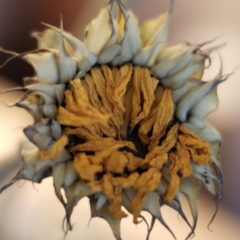



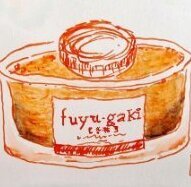
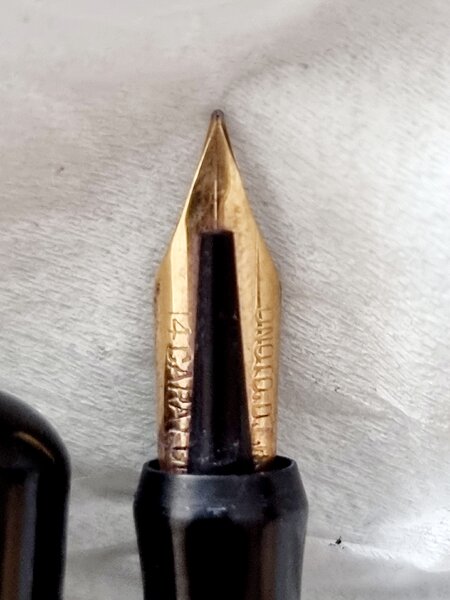
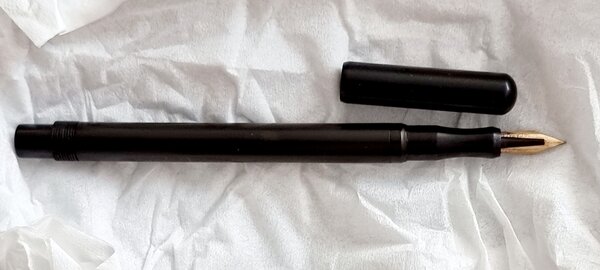
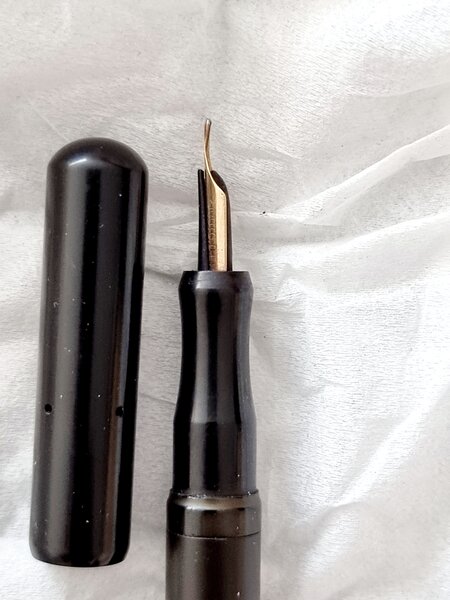
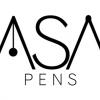
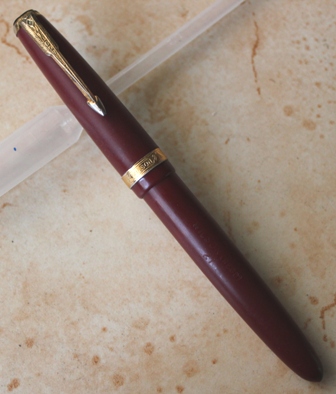
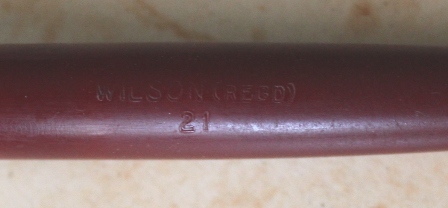
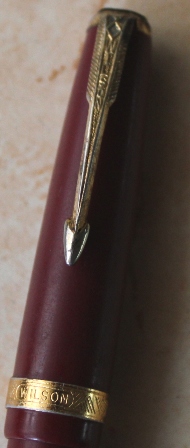
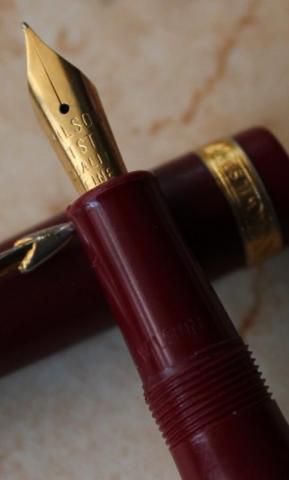






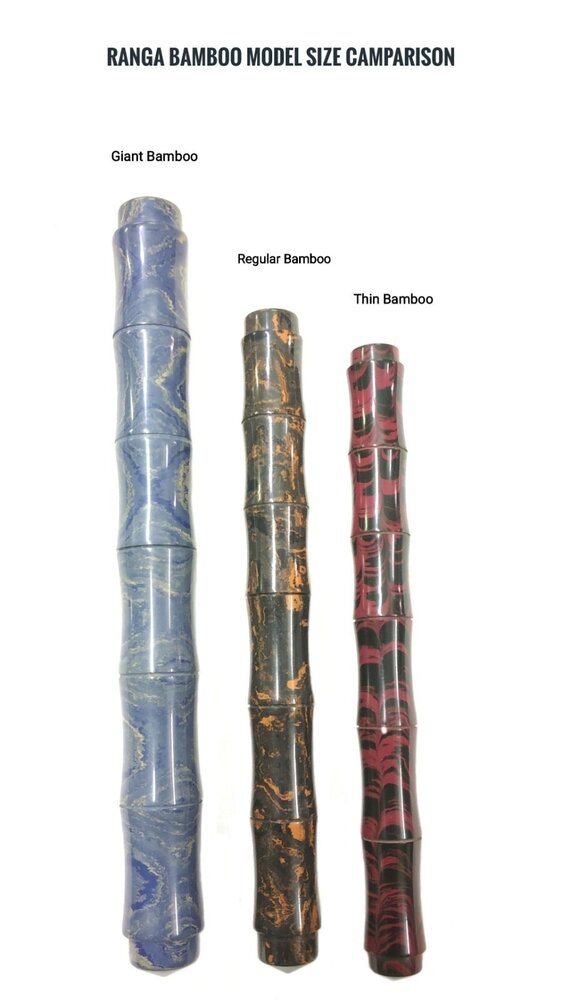















.thumb.jpg.e2562f8f6b6e6cf1e5f659ec4f4b13ae.jpg)








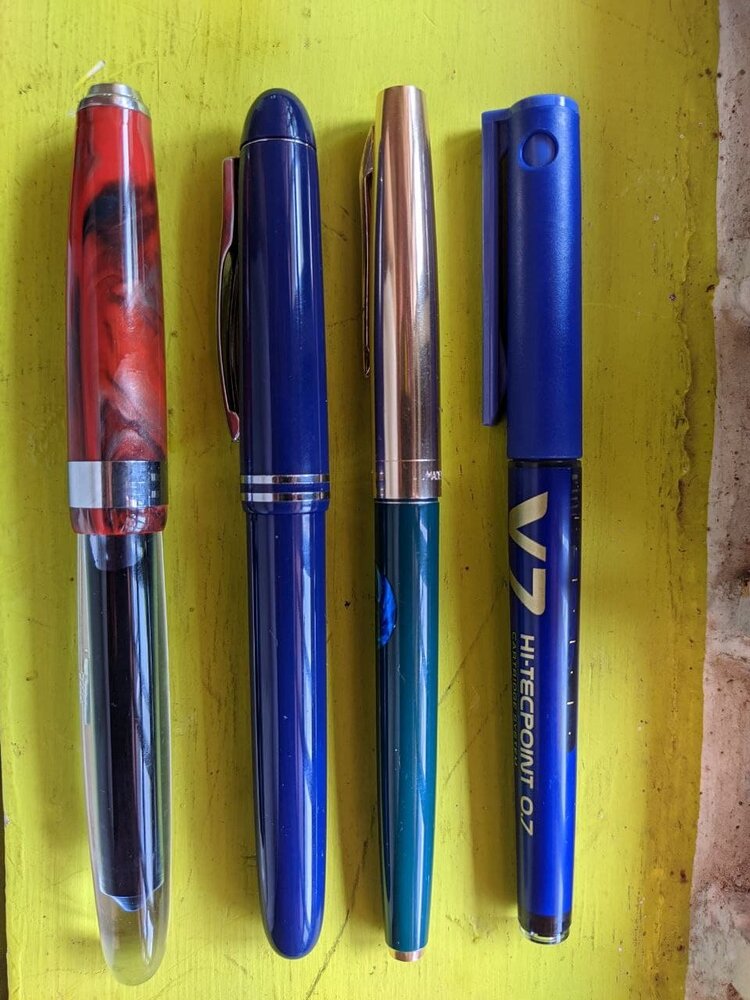
.thumb.jpg.ad224d0f9ef0a84e58df991bae5d135c.jpg)

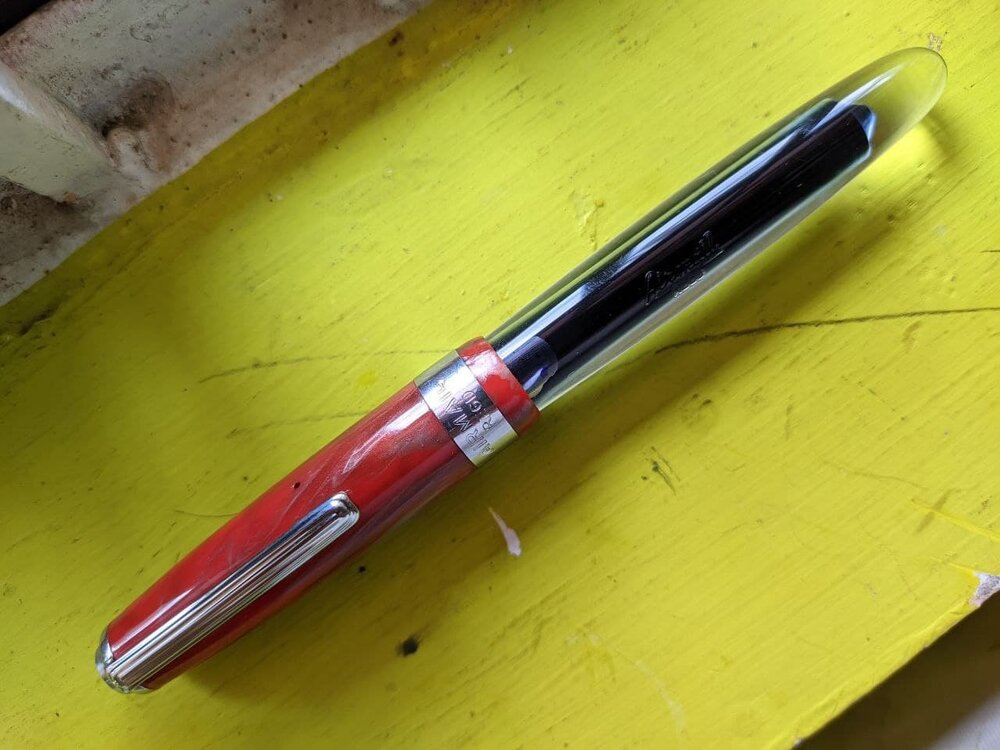


.thumb.jpg.87bacfaab1b6940e70edccc78c6091d6.jpg)




